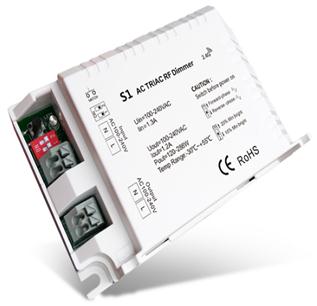
The purpose is to match the load requirement of the dimmer while storing the energy in the boost output capacitor. It then provides a dynamic impedance to interface the dimmer by driving the boost BJT (B DRV pin). If a dimmer is connected, the block detects the type of dimmer by analyzing the shape of the rectified AC waveform (V IN pin). PFC operation depends on the input voltage (V IN pin), the boost output voltage (V CB pin), and the magnetic flux status of the boost inductor (BV SENSE pin). If no dimmer is connected, the block switches the boost BJT (B DRV pin) for PFC and stores the energy in the boost output capacitor. It analyzes the rectified AC waveform and determines whether a dimmer is connected on the line. The power factor correction (PFC) and dimmer interfacing block control the boost converter as the first power stage in the iW3616 system ( Fig. The iW3617 is available in two versions, the iW3617-00 optimized for 120 VAC input applications and the iW3617-01, optimized for 230 VAC applications. The iW3616 is available in two versions, the iW3616-00 optimized for 120 VAC input applications and the iW3616-01, optimized for 230VAC applications.

They also incorporate iWatt’s proprietary PrimAccurate™ primary-side control technology, which minimizes external component count. They simplify dimmer design and provide a very robust solution by integrating iWatt’s EZ-EMI ® technology.įeatures include the ability to run off of an emergency backup DC voltage rail in the event of a power outage and a temperature protection circuit that reduces the output drive to the LEDs to protect against overheating while maintaining light output. The iW3616 and iW3617 do not require the bleeder resistor.īoth the iW3616 and iW3617 are compatible with solid-state lighting industry standard Zhaga for hot-plug LED modules and also incorporate mapping options for the dimming function that falls within the NEMA SSL6 dimming curves for incandescent replacement bulbs. Flickerless technology also removes virtually all visible and invisible LED flicker to provide a stable light output under all conditions.Ī triac dimmer normally requires a high-power bleeder resistor across the load, which increases solution size and cost. Incorporating iWatt’s proprietary Flickerless™ technology, they automatically detect the dimmer type and phase, providing compatibility with analog and digital dimmers. Both controllers are compliant with the IEC6 standard for electromagnetic compatibility (EMC). The iW3616 is rated at 12W and the iW3617 has a 25W rating. They are two-stage AC/DC power supply controllers optimized for dimmable LED luminaires.
#Triac dimmer for led lights drivers#
Flicker is an issue with LED lamps, as explained in the sidebar, “Look Out For Flicker.”Īmong the new “smart” LED drivers intended for use with existing triac dimmers are iWatt’s iW3616 and iW3617.
#Triac dimmer for led lights driver#
Thus, the 120 Hz triac drive voltage can appear as flicker using an LED, unless a “smart” LED driver modifies the triac output to eliminate flicker. In contrast, the LED is a nonlinear load in which lamp current and voltage depend on the diode-like performance of an LED.įurthermore, the LED responds much faster than an incandescent lamp to changes in applied voltage. 2 does not cause the light output to flicker. Due to the thermal inertia of the incandescent lamp’s filament, the pulsed input voltage of Fig. The incandescent lamp is resistive so the voltage and current through the lamp have a linear relationship. There are major differences between driving an incandescent and LED lamp, which are related to load impedance and response time to an applied voltage. Varying potentiometer (R1) varies the amount of the ac waveform that is cut, which varies the incandescent lamp brightness.

Therefore, the triac dimmer circuit cuts both halves of the ac sine wave input, as shown in Fig. Because the triac acts like two back-to-back silicon controlled rectifiers it can conduct in either direction. The typical triac lamp dimmer circuit consists of the relatively simple circuit shown in Fig.1.

To understand the technology associated with practical LED dimming we first have to look at the technology associated with triac-based incandescent lamp dimmers.


 0 kommentar(er)
0 kommentar(er)
